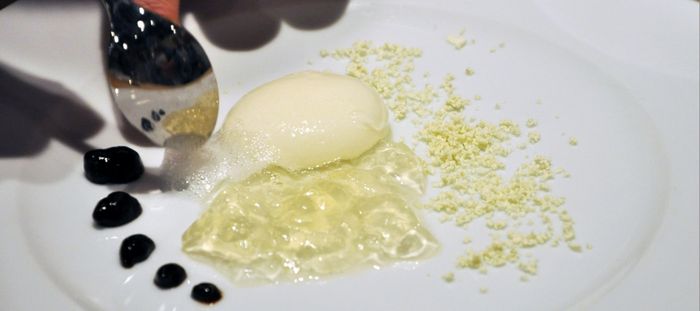Molecular Gastronomy: Apply Science to Your New Year’s Diet
What do you think the above dish would taste like?
At first glance, I might imagine the dish above to taste like a scoop of vanilla ice cream on top of champagne gelatin with a sprinkle of crushed pistachios and chocolate on the sides. But my opinion doesn’t count because I have already tasted it and it does not resemble anything like a dessert. If you happened to guess a Caprese Salad right off the bat then you are way out of my cooking league and I should be reading your blog.
Last month I had to rush after work so I could attend a cooking class at Sur La Table called ‘Molecular Gastronomy Basics’. Usually Molecular Gastronomy is something you relate to as a foodie topic or see on Top Chef. Sounds fancy, yes, but it is actually not as scary as you think. Everything that we made in the class was easy to put together and not rocket science, just the good old fashioned kind like you took in college (unless you went to design school like me).
Technically, Molecular Gastronomy is a discipline practiced by both scientists and food professionals that studies the physical and chemical processes that occur while cooking, according to our good friends at Wikipedia.
 Practically, Molecular Gastronomy is an impressive way of saying you are cooking. It is figuring out different ways for ingredients to come together and creating new textures to experience. There is more precision involved, but other than that it just takes a lot of practice. So, to begin the above deconstructed masterpiece of a caprese salad we first started out making Inverted Mozzarella Spheres by blending the mozzarella with some heavy cream to get a liquid consistency. Then we added some calcium lactate gluconate to the mixture and used a deep spoon to transfer it into an algin bath for spherification. What you get in the end is a mozzarella ball that has a skin on the outside and contains the liquid form inside so that when you puncture it, everything oozes out. (I know it sounds intimidating, but I promise it’s not!)
Practically, Molecular Gastronomy is an impressive way of saying you are cooking. It is figuring out different ways for ingredients to come together and creating new textures to experience. There is more precision involved, but other than that it just takes a lot of practice. So, to begin the above deconstructed masterpiece of a caprese salad we first started out making Inverted Mozzarella Spheres by blending the mozzarella with some heavy cream to get a liquid consistency. Then we added some calcium lactate gluconate to the mixture and used a deep spoon to transfer it into an algin bath for spherification. What you get in the end is a mozzarella ball that has a skin on the outside and contains the liquid form inside so that when you puncture it, everything oozes out. (I know it sounds intimidating, but I promise it’s not!)
 The other parts to the salad involve turning tomato water into a tomato gelée, pureeing basil with oil and tapioca maltodextrin to create a basil powder, turning balsamic vinegar into a pudding consistency, and finally a salt foam to tie it all together. You have to save this for last because it will start to deflate after 10 minutes or so. Making foam is the easiest thing you can do. All you need is an immersion blender, water, sea salt, and soy lechithin which you can easily find. Once you plate the dish and take that first bite, you wonder how it can still taste like a caprese salad. Interestingly enough it does. Everything does not come together immediately. Your tastebuds slowly analyze each component of the dish, but when the flavors do all come together it tastes like you are eating the real thing!
The other parts to the salad involve turning tomato water into a tomato gelée, pureeing basil with oil and tapioca maltodextrin to create a basil powder, turning balsamic vinegar into a pudding consistency, and finally a salt foam to tie it all together. You have to save this for last because it will start to deflate after 10 minutes or so. Making foam is the easiest thing you can do. All you need is an immersion blender, water, sea salt, and soy lechithin which you can easily find. Once you plate the dish and take that first bite, you wonder how it can still taste like a caprese salad. Interestingly enough it does. Everything does not come together immediately. Your tastebuds slowly analyze each component of the dish, but when the flavors do all come together it tastes like you are eating the real thing!
Although I probably will not be making any multi-course meals with this new found science any time soon, what I have concluded is that if you are having a dinner party and really want to impress guests with your cooking just put some foam on the dish because people looove foam!







